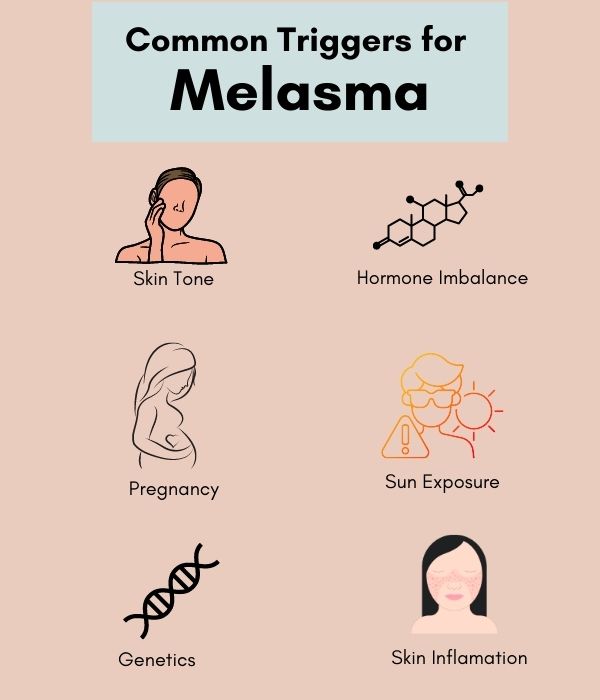
Melasma is a commonly known disease that can affect any individual, especially women wherein it causes brown or grey-brown patches on the skin. This condition is particularly noticeable on the face, neck, and arms and can be a source of significant cosmetic concern for those affected by it. In this article, we will delve into the causes, symptoms, and treatment options for melasma to provide you with a better understanding of this condition.
Causes of Melasma:
There is no certain reason behind causing of melasma as it happens due to a combination of factors including hormonal changes, sun exposure, genetics, and certain medications.

- Hormonal changes: Hormonal changes such as pregnancy, oral contraceptives, and hormone replacement therapy can trigger the production of melanin, the pigment that gives colour to the skin and cause melasma to develop.
- Sun Exposure: When your body comes in direct contact with the sun then it can also trigger melanin production and make your melasma worse.
- Genetics: Around 33 percent – 50 percent of people suffering from melasma have reported that someone in the family has it.
Symptoms of Melasma:
The appearance of brown or grey-brown patches on the skin is the primary symptom of melasma. These patches can appear on the face, neck, arms, and other areas that are exposed to the sun. Generally, these patches are symmetrical and uniform in colour and texture.
Diagnosis of Melasma:
When it comes to examination and diagnosis of melasma your entire medical history and primary symptoms of skin patches are considered. A dermatologist in South Delhi may perform a skin biopsy to confirm the diagnosis and rule out other skin conditions that may cause similar symptoms.
Treatment Options for Melasma:
Melasma can be a difficult condition to treat, but there are several options available to help improve the appearance of the skin. These options include:
- Topical creams and gels: Topical creams and gels that contain hydroquinone, a skin-lightening agent, can be effective in reducing the appearance of melasma.
- Chemical peels: Chemical peels can help to remove the top layer of skin and improve the appearance of melasma.
- Microdermabrasion: Microdermabrasion can help to remove the top layer of skin and promote the growth of new, healthy skin.
- Laser therapy: Laser therapy can help to improve the appearance of melasma by reducing the production of melanin and removing the affected skin cells.In addition to these treatment options, it is important to protect the skin from the sun and to use a broad-spectrum sunscreen with an SPF of 30 or higher to help prevent melasma from becoming worse.
Prevention of Melasma:
The best way to prevent melasma is to protect the skin from the sun and to use a broad-spectrum sunscreen with an SPF of 30 or higher. Additionally, avoiding triggers such as hormonal changes and certain medications can also help to prevent melasma from developing or becoming worse.
Conclusion
Melasma is a common skin condition that can be a source of significant cosmetic concern for those affected by it. Understanding the causes, symptoms, and treatment options for melasma can help individuals make informed decisions about their skin health and take steps to improve the appearance of their skin and you can rely on SkinQure for this. By taking the necessary precautions and seeking treatment when necessary, it is possible to manage melasma and maintain healthy, beautiful skin. In this regard, you cannot overlook Melasma treatment in South Delhi.
